Rose white, rose scarlet ... (part 1)
Until you take the throne,
Which house the Lancaster owns,
By God, I will not close my eyes.
Here is the king of the cowardly palace
And there is his throne. Own it, York;
He rightfully belongs to you,
And not the posterity of Heinrich the Sixth.
William Shakespeare. "Henry VI." Part Three Translation E. Birukova
The struggle of the two dynasties, the Yorks and Lanksters, entered into history England as the war of scarlet and white roses. No, no, yes, both venerable scientists and modest lovers of the history of the Middle Ages return to this amazing page in the life of two famous families. Let us try and we go back a few centuries ago, look into the past and feel the spirit of that time, the time of palace secrets, intrigues and conspiracies. Let's start with an explanation of the term itself. It became used only in the 19th century, after Walter Scott based on the fictional scene from William Shakespeare’s tragedy I Henry VI, in which opponents choose roses of different colors in the Temple church, used it in the story Anna Geyershteynskaya.
Participants in the historical reconstruction on the street of St. Albans.
Although roses, as symbols, were actually used during the war, the majority of the participants naturally used symbols of their own emblems or overlords. For example, the troops of Henry at Bosworth fought under a banner depicting a red dragon, and the Yorkists used the personal symbol of Richard III - the image of a white boar. Roses, as symbols, began to matter later, when King Henry VII at the end of the war combined red and white roses into a single red and white Tudor Rose.
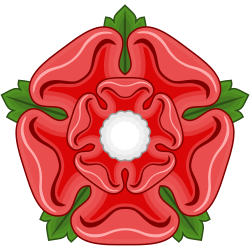
Red Rose Lancaster.
For some reason it was believed that the “Rose confrontation” was at that time one of the longest and bloodiest wars in England, since, they say, it lasted thirty years, from 1455 to 1485.
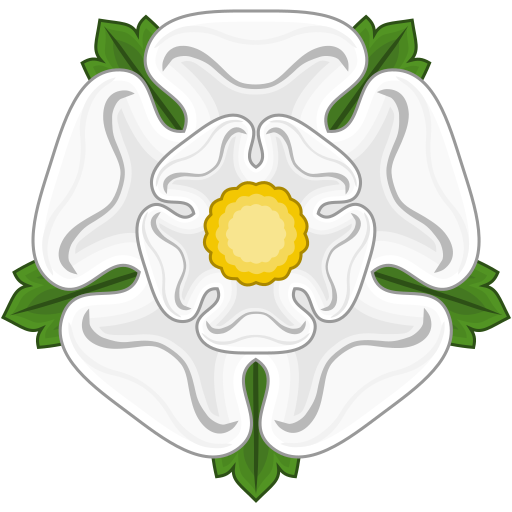
White Rose of York.
Such a point of view is the merit of the Tudor advocates who tried to defame the previous government and put Heinrich Tudor as the defender of the fatherland and his main benefactor. So it was always, at all times, after the successor ascended to the throne, the chronicles were in haste, the libraries were shaken up, so that, God forbid, no negative information would cloud the new ruler.
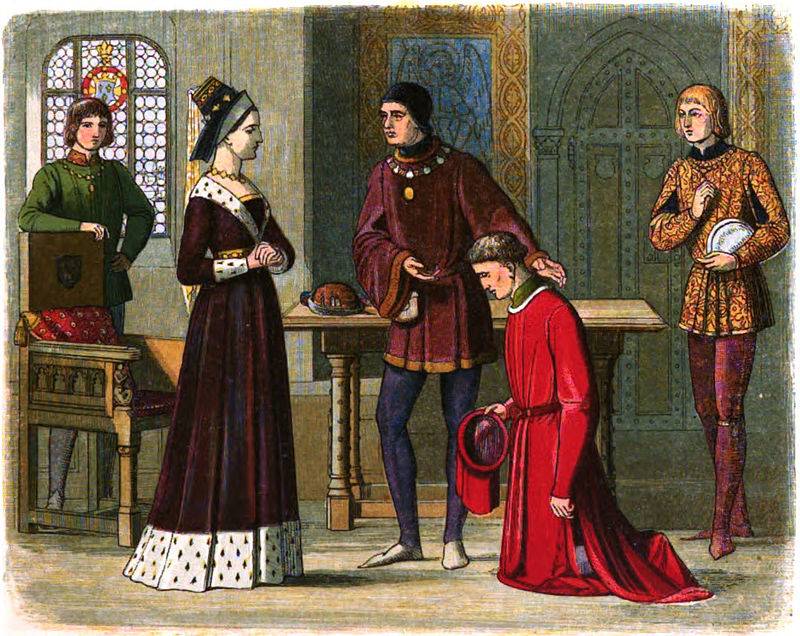
Count Warwick in front of Marguerite of Anjou. (“The Chronicle of England.” Page 417. British Library)
As for the duration of the war, after a careful analysis of the events, it becomes obvious that almost all campaigns took three to four months, after which the active military phase passed into the passive, backstage, and more specifically, intrigue. Several times an undeclared truce came, which was caused by the need to recover from the defeat of one of the parties.
A confirmation of the talk of bloodiness can only serve the loss of the old English aristocracy. A true picture of the loss will help provide a comparison of the composition of the parliament before the war and after it. In the parliament, convened by Heinrich Tudor after a devastating victory in the war, there were only 20 lords, against 50, who met before the war. By the way, most of these twenty received their titles already during the war. The opposing sides, ruthlessly destroying the captive nobles, were very generous towards the prisoners of the simple class. And of course they did not carry out any punitive actions against the population. On the contrary, people were constantly asked for help. Yorks, appealing to the patriotic feelings of the people, tried to achieve his favor, emphasizing that they were a national party. According to York, Margaret d'Anjou, being a Frenchwoman, could not take care of the English people as much as she should.
An interesting fact is that after the victory of one of the parties, a parliament was immediately convened, the purpose of which was to obtain the approval of the representative body of government and legally formalize the results of the victory. None of the parties opposed the current system of government. And the war was only the highest point of the dynastic struggle between the Yorks and Lancaster, and in no way affected the existing system of government.
“England and York! England and Lancaster! ”
The beginning of the rule of the feeble-minded Henry VI of Lancaster was very calm, and all the outbreak of internal conflicts were instantly resolved by his surroundings by peaceful means. The reason for this calm was simple. The entire elite of the English aristocracy was drawn into the “Hundred Years War”, and it took the most active part in it, fiercely fighting on the mainland. Thus, the probable “candidate” for the throne is Duke Richard York, who was the grandson of the son of Edward III (as well as the ruling king Henry) fought in Normandy, holding the post of “lieutenant of all France”. His foe, John Beaufort (died in 1444), was in France.
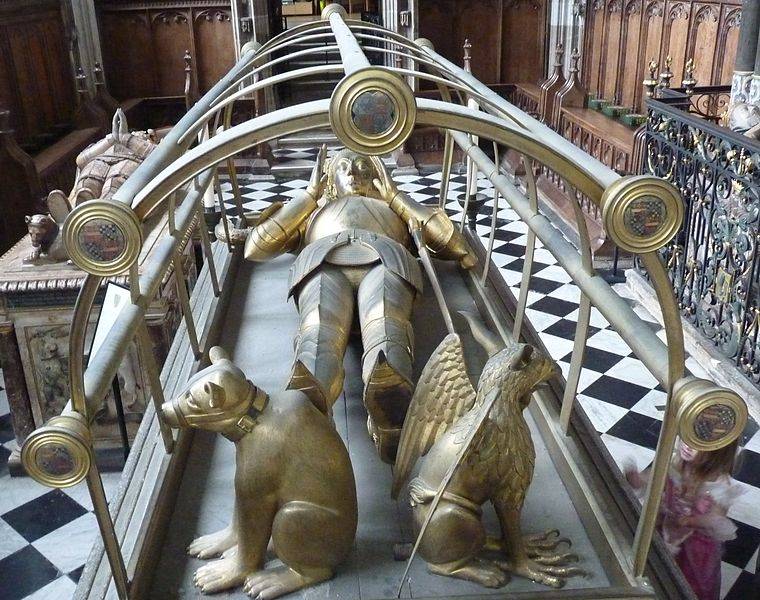
The famous gilded effigiya of Richard Boscham, 13-th Earl of Warwick (1382 – 1439) in the Church of Sts. Mary in Warwick, England.
Same effect, side view.
Henry VI was pious, overly sensitive, and also extremely naive. In addition to the lack of tricks, he still lacked intelligence. In essence, this was an ordinary person who was poorly versed in international politics (as well as in domestic politics as well). Many contemporaries said that in him more from the hermit than from the king.
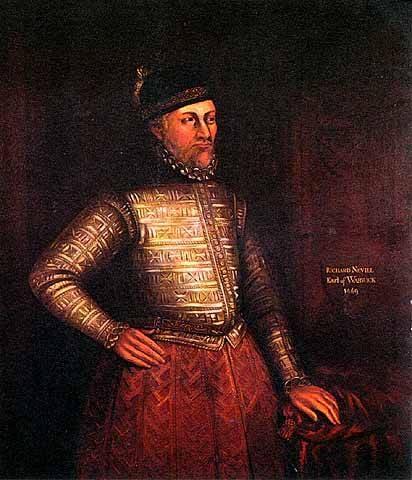
Richard Neville, Earl of Warwick. Portrait of an unknown artist.
Anyone who was able to have a little influence on the king had absolute control over the royal court, because His Majesty unconditionally agreed to what was required. In addition to all the “virtues”, Heinrich inherited from his eminent grandfather periodic fits of madness. Well, how could a king with such a "set" of hereditary "sores" manage the state?
The position of England in the Hundred Years War was getting worse and worse, and in the royal entourage the party of peace prevailed, whose leader, Count Suffolk, offered to arrange an alliance through the marriage of the king and a certain French noble lady, through whom a truce would finally be established, and with it French appetites will die in English territory. The bride turned out to be a young Margaret of Anjou, the niece of the French king and the daughter of the influential René of Anjou. Wanting to conclude a lasting peace, the two peoples declared a truce, but at this time England received an excellent bride for her sovereign. However, the plan was attractive only in theory. In fact, during the negotiations, Rene Anjou explained that he would not only give no dowry for his daughter, but also insistently demanded the Isle of Man and England itself.
The marriage ceremony nevertheless took place, and the court union, which included Earl Suffolk and Edmund Beaufort (brother of the deceased John Beaufort Duke Sommerset), was now led by Queen Margaret of Anjou (lady, by the way, very determined, ambitious and vindictive). The decision to make peace was successfully implemented. They were opposed by York, who remained in disgrace. His party then included highly influential members of the Neville family: Earl Richard Salisbury, as well as his son Richard, Earl of Warwick.
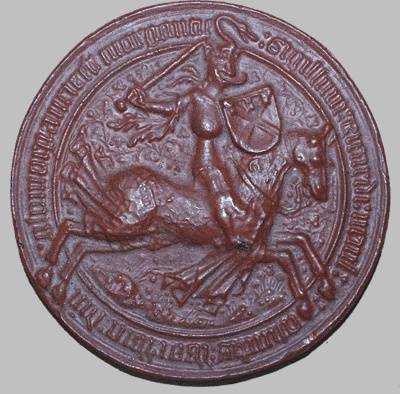
Seal of Richard Neville, Earl of Warwick.
Whatever it was, but the conclusion of peace with France brought England more harm than good. Unsuccessful war, plus the presence of disgruntled aristocracy led by the claimant to the throne, a considerable number of free people who can only fight and can not do anything else, a rapidly empty treasury - all this was the reason for unleashing the "War of the Roses."
The origin of this name is found in Shakespeare in his tragedy Henry VI, in a scene where York and Somerset point to a white and red rose, as a symbol of their enmity - in the arms of York was a white rose, and Lancaster - red. Both sides had many supporters. Lancaster, for example, supported in the northern and north-western regions of England, York - in the south and south-east. So gradually the political struggle turned into armed struggle.
Duke Sommerset led the troops of Lancaster, and Earl Warwick led the Yorks. For the first time, battle cries began to sound over the green fields: “England and York! England and Lancaster! ”
What are the types !!! All the same, as in that distant time ...
The first battle took place near the small town of St. Albans 22 May 1455. Adherents of Lancaster numbers around 3 000 people took refuge behind the barricades in the city and managed to repel the first onslaught more than twice as large as the number of Yorkists. The number of troops of the Duke of York was 7 000 people. The detachment, headed by Count Urvik, quietly made his way to the quiet outskirts of the streets and, bypassing a rather extensive garden, suddenly struck Sommerset's troops in the rear. The soldier was panic-stricken, it was decidedly impossible to command the troops scattered about, and the battle broke up into separate segments on the streets of the city.
The battle ended in victory for the White Rose supporters. Oddly enough, there were very few casualties - around 100 people, mostly from the enemy. Heinrich's loyalists — Edmund Beaufort, Duke Somerset, Humphrey Stafford, Clifford, Henry Percy, Harington — killed in a fight. Heinrich himself did not take part in the hostilities, but was accidentally wounded by an arrow and made an attempt to hide in one of the houses where the soldiers found him.
Under pressure from York and Warwick, Heinrich declared the supporters of Somerset to be his enemies in Parliament, and the actions of York to be completely legitimate rebellion for the sake of the liberation of the king. He returned a high position at the court. Warwick appointed Captain Calais - at that time the only port in France, remained in the hands of the British. After becoming captain, Warwick began to energetically free the English Channel from pirated and simply undesirable ships. Sometimes it seemed that he destroyed everything that was moving in the Straits. So, having met five Spanish ships on the way, Warwick sank three, at the same time interrupted a lot of Spaniards, and on another occasion seized the ships of the friendly city of Lübeck, which resulted in an immediate diplomatic scandal. But, anyway, these active actions Captain Calais once again approved his reputation. In addition, he won the authority of his garrison, which at that time consisted of experienced, battle-hardened soldiers, and the city of Calais for many years ahead made the base of supporters of York.
Now, it seemed, peace and tranquility should prevail, but Queen Margaret once again tries to influence her husband by promoting her own plans that she alone knows, and York never abandoned the idea of the throne. Both sides hastily prepared the troops, recruited supporters and slowly prepared for the continuation of the war. Margarita tried to destroy Warwick twice. At first he was invited to Coventry. Warwick, who didn’t trust Margaret too much, thought of putting forward a small cavalry unit in which a man dressed in his clothes rode. The trick was a success - upon entering the city, the Queen’s people attacked the squad, mistakenly believing that Warwick himself was in front of them. Another time, he, as if on behalf of Heinrich, was called to report on his service as Captain Calais. During the conversation, he heard the sounds of the struggle, which were heard from the courtyard. Looking out of the window, Warwick beheld his people fighting violently from the royal soldiers. Instantly descending into the courtyard, he immediately joined his soldiers, and together they broke through to their ship, which was waiting on the Thames.
Meeting Warwick and Margaret of Anjou. Fig. Graham Turner.
Hostilities resumed in the autumn of 1459. York supporters were going to unite at Lidlow. In September, one of the large units, numbering about 4 000 man, led by the Earl of Salisbury, was intercepted in Blor-Heath by a Lancastrian army numbering about 8 000 man. Details of the course of the battle are missing It is only known that the Lancastrian cavalry, which rushed to the attack, was first shot by archers, and then attacked by infantry. Losing order in the ranks, she left the battlefield in panic. Losses amounted to about 3000 people, of whom approximately 2000 Lancasters.
The groups of supporters of York united in Ladfort, and their total number was about 30000 people. Not wanting to resist the king anymore, Andrew Trollop and his squad went over to the side of the Lancasters. Heinrich promised to pardon the soldiers who lay down weapon and go over to his side. And now the army of York began to thaw rapidly, and York and its people had to flee. After that, the remnants of the army surrendered and Heinrich captured Lidlow. There was the Duchess of York and her two young sons, George and Richard (who would later become Richard III).
York, through Devon and Wales, moved to Ireland, Warwick hastily went to his garrison in Calais. However, he was soon deprived of the position of Captain Calais and the young Sommerset was appointed in his place. But the garrison and the sailors refused outright to obey the new commander. In June, 1460, Somerset came across the ships of his successor in the strait, attempted to attack them, but the teams of his ships went over to the side of the enemy. Earl Warwick and Edward York, having obtained this very unexpected reinforcement, together with the two thousand army landed in Kent, and quickly captured London. After that, they moved against the royal troops stationed in Coventry.
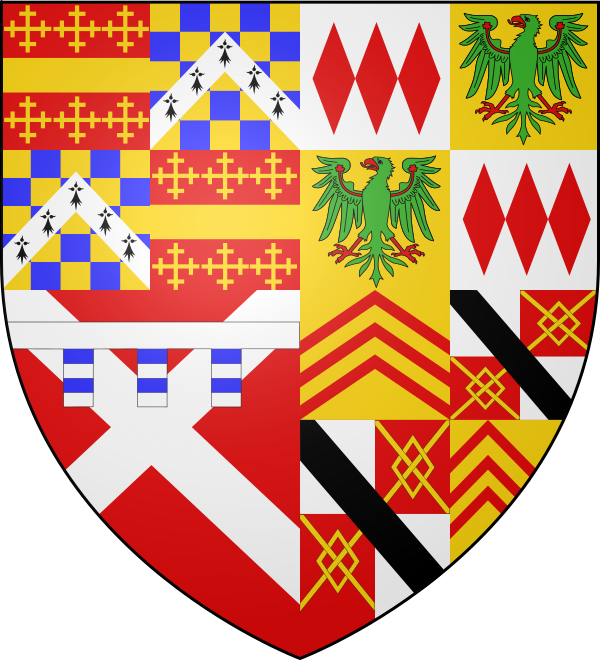
The coat of arms of Warwick is so interesting that it makes sense to describe it, it would be more correct to say - to blazonirovat according to all the rules of heraldry. The founder of the clan, Richard Neville Sr., was the youngest son of Ralph Neville the First Earl of Westmoreland and received his father's coat of arms - in a scarlet scarlet scarlet (ie St. Andrew's) silver cross. But since he was the youngest in his family, an image of the title in the colors of the Lancaster family, silver and azure, in honor of his mother Joanna Beaufort appeared in it. After the death of Count Thomas Montague, who was the fourth earl of Salisbury, Richard married his heiress, which gave him the title and the coat of arms of the Salisbury clan - a four-piece shield - which has three scarlet spindles in a silver field and a green gold field an eagle spread its wings. He also placed all the emblems on his coat of arms in order of precedence. The son of Richard, and also Richard, entered into marriage with Anna Beauchamp, heir to the thirteenth Earl of Warwick. His coat of arms included the Boshanov coat of arms (in the scarlet field a golden belt and six crossed crosses of gold), the coat of arms formerly owned by Warwick graphs to Newburgh (alternately in azure and azure rafters with an ermine fur), the coat of arms of Claires with three scarlet lines in the gold field Despensers - the quadruple shield - alternately silver and scarlet, in which the first and fourth quarters are intertwined with gold, and the left - with a black tie over everything. This emblem of Richard Beauchamp was also received by marrying Isabella, the daughter and heir of Thomas Despenser, the first Earl of Gloucester, a descendant of Gilbert de Claire. Interestingly, the shield of Richard Neville Count Warwick was depicted only his family coat of arms. But here his banner, fluttering over the castle, and the blanket of his horse were decorated with all the details of these emblems. The first in seniority were the emblems of Warwick and Salisbury, they were in the first and second quarters, the Neville coats of arms in the third, the Despensers coat of arms in the fourth. Neville also had two Kleynod - a swan head rising from the crown of red (for the coat of arms of Warwick), and a griffin on the crown (for the coat of arms of Salisbury). His personal emblem was a bear on chains and coarse, unhewn stakes.
Battle of Northampton
19 July 1460, at the place of Northampton, located south of Coventry, another battle broke out. York's forty-thousandth army defeated Henry’s twenty-thousand army for half an hour. The queen managed only miraculously to escape from captivity, and she hurried out of England and fled to Scotland. Poor Henry was again captured and taken to London.
Northampton battle plan
Richard York delivered a speech in front of Parliament and frankly declared his desire to occupy the throne of England. His statement met a storm of indignation even among his supporters. The only thing promised to him was the granting of the throne after the death of King Henry. With this did not want to put up Queen Margaret, who by that time had managed to gather a new army, consisting of the Scots and the Welsh.
Richard York with the 5 000 man advanced to meet her. And on December 30, 1460, at Wakefield, took place on the 6 mid-battle. The army of Lancaster, commanded by Heinrich Beaufort, second duke of Somerset, Lord Henry Percy, inflicted a heavy defeat on the Yorkists. Some sources claim that the queen's advocates used military trick, dressing around 400 a man in liveried supporters of York. Warwick's father, Earl of Salisbury, was captured and later beheaded, and York himself died in battle. The heads of York and Salisbury, by order of Margarita, were nailed above the gates of the city of York.
Since then, the country has irreversibly divided into two parties. Already 2 February 1461, Edward, the new Duke of York, utterly defeated the enemy's army with a number of 4 000 people.
Most of the well-born captives were executed, thus creating a precedent for mass executions of nobles in this war.
The second battle of St. Albans. Fig. Graham Turner.
17 February 1461, the royal army attacked Warwick's small army at St. Albans. Paradox, but the attacked army of York suffered a defeat in exactly the same place where the Yorkists won their first victory six years ago. Henry VI was released. The queen hurried back to London. But the young Duke of York arrived there first and not without the help of Warwick, as well as with the support of the people, 4 March 1461 was crowned to the throne under the name of Edward IV. In England, there were two kings, and now the question arose: “Which of them will hold the throne?” A couple of days after the ceremony, Edward IV and Richard Neville, who received the nickname “creator of kings” after the story of Edward IV, went to the royal army, the path of which could easily be traced to the ravaged villages (which was the work of the Scots Margarita). Margarita's army always considered England an enemy country, and the unfortunate villages surrendered to plunder as a reward. The true reasons were carefully hidden: the queen simply did not have enough money to pay the troops.
To be continued ...
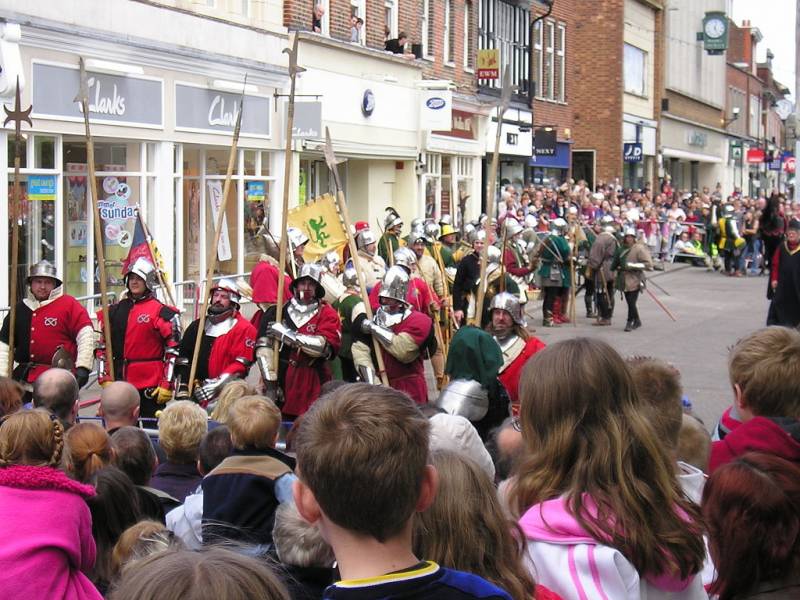
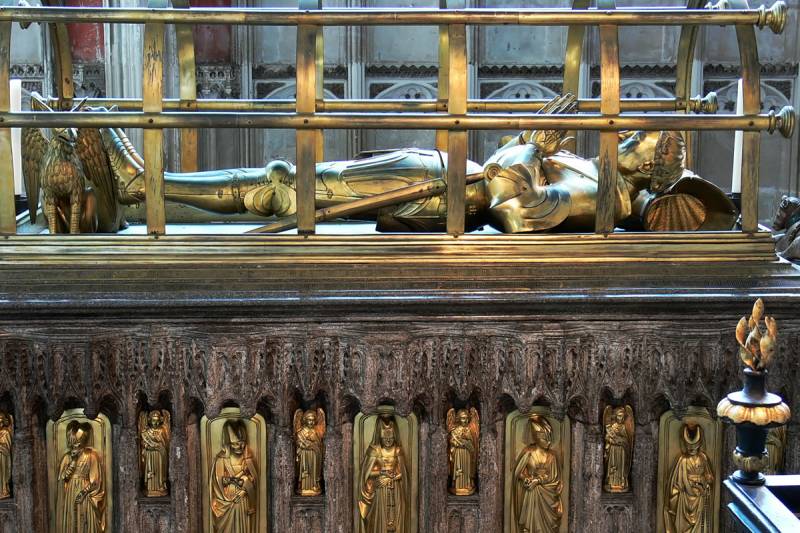
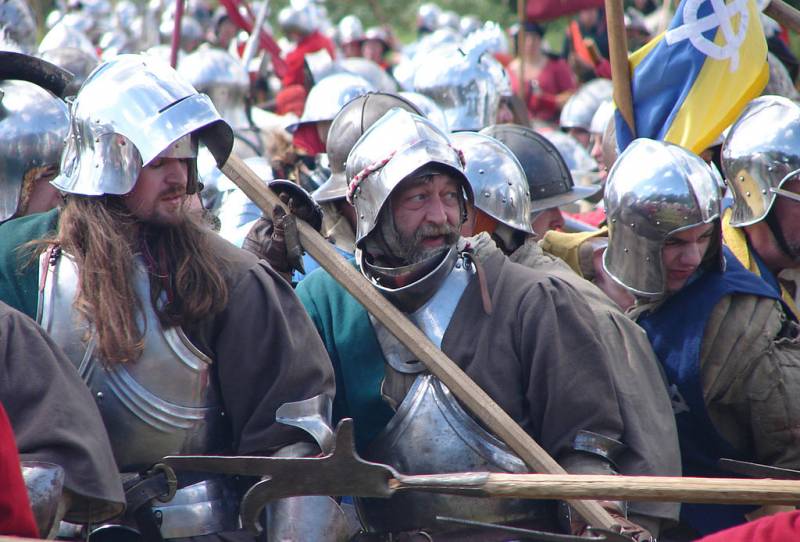
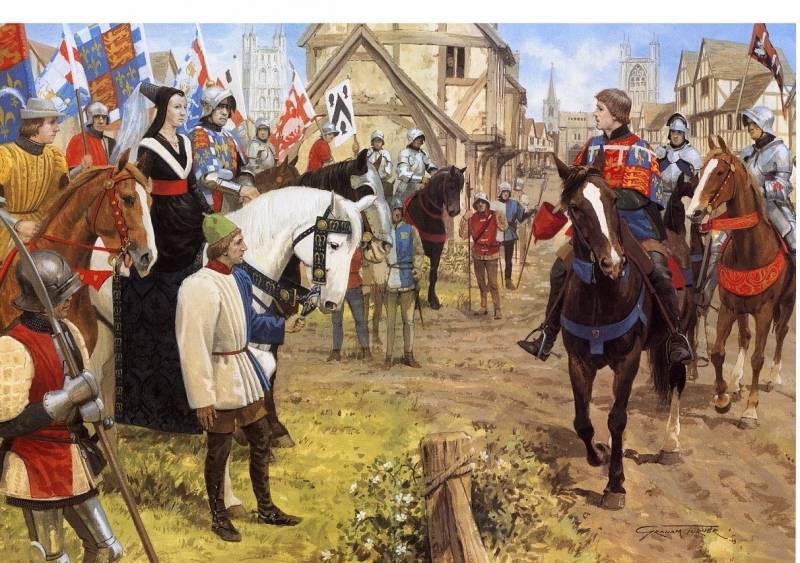
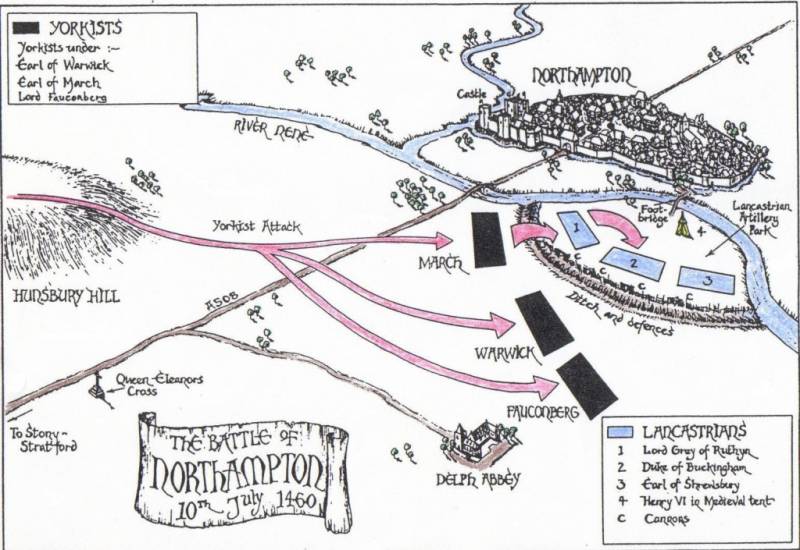
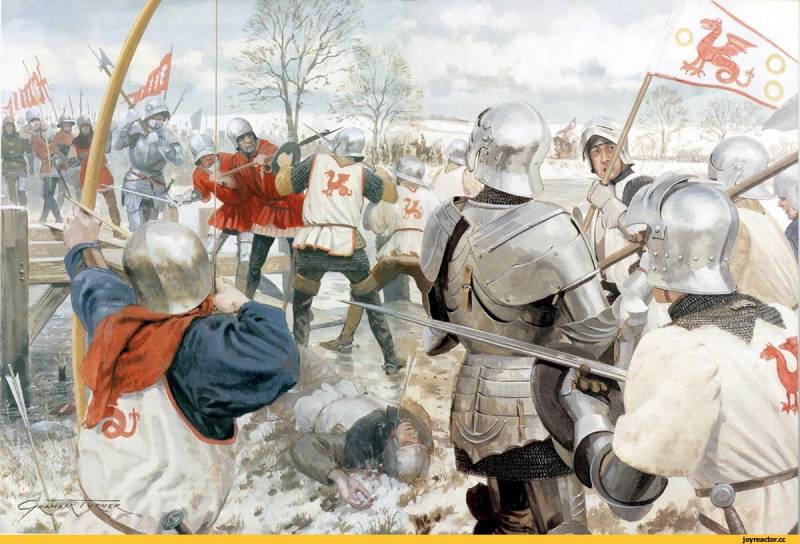
Information